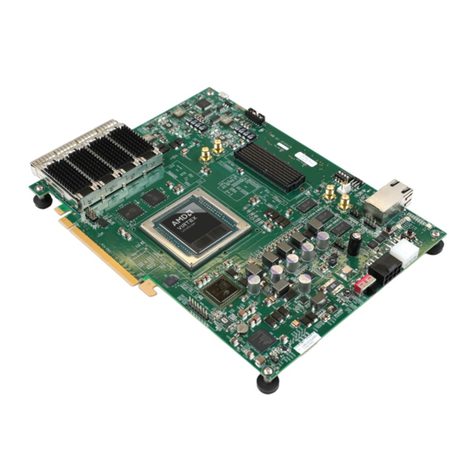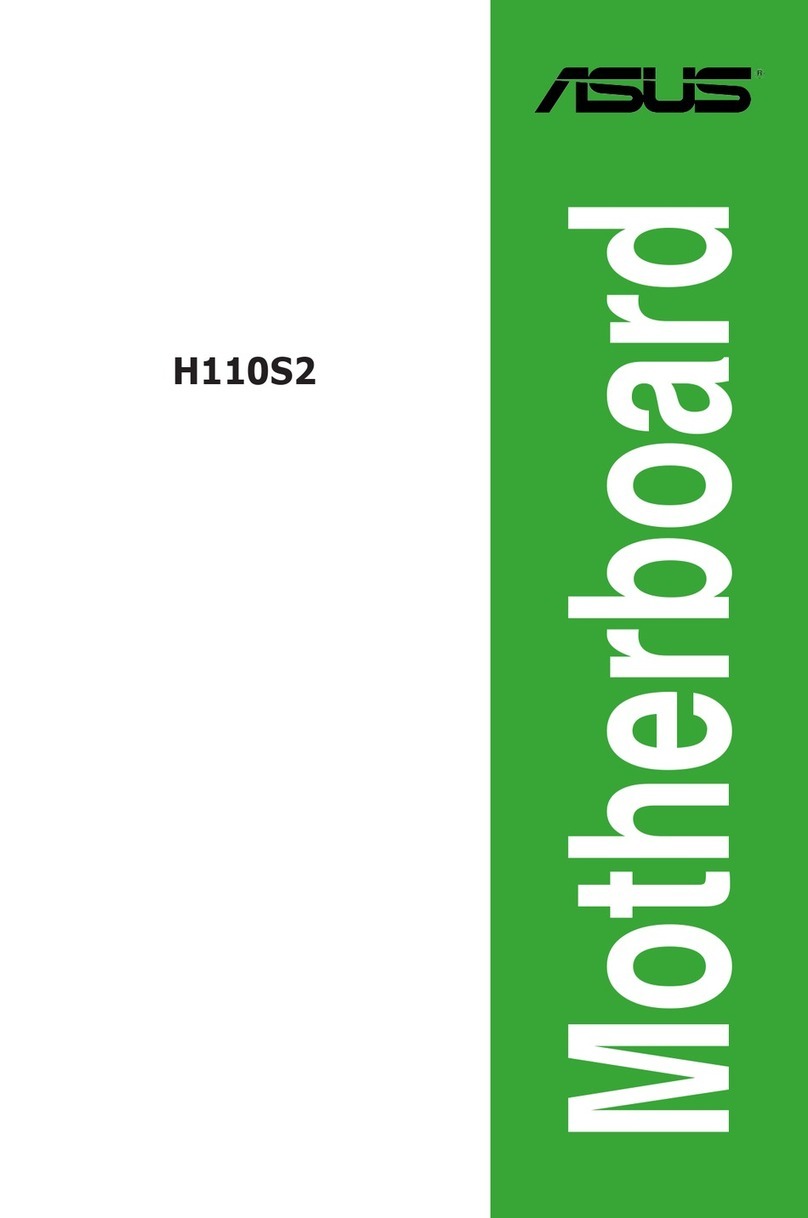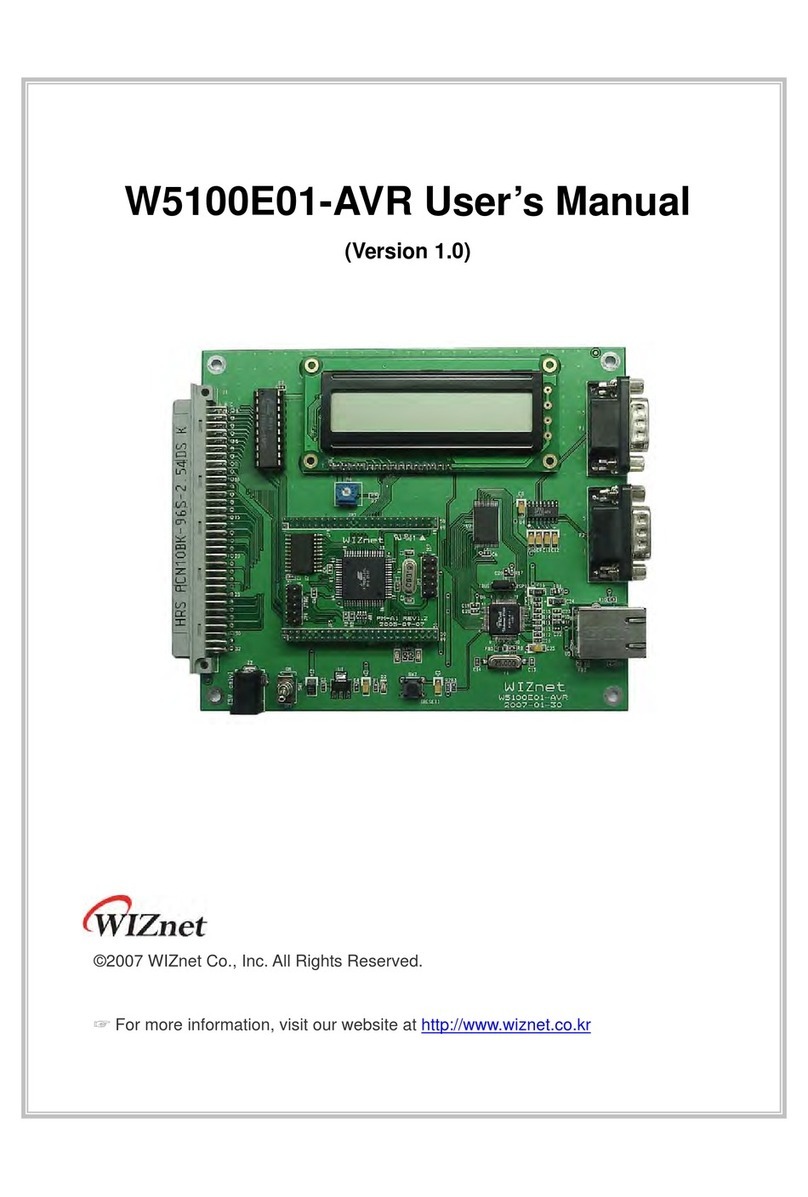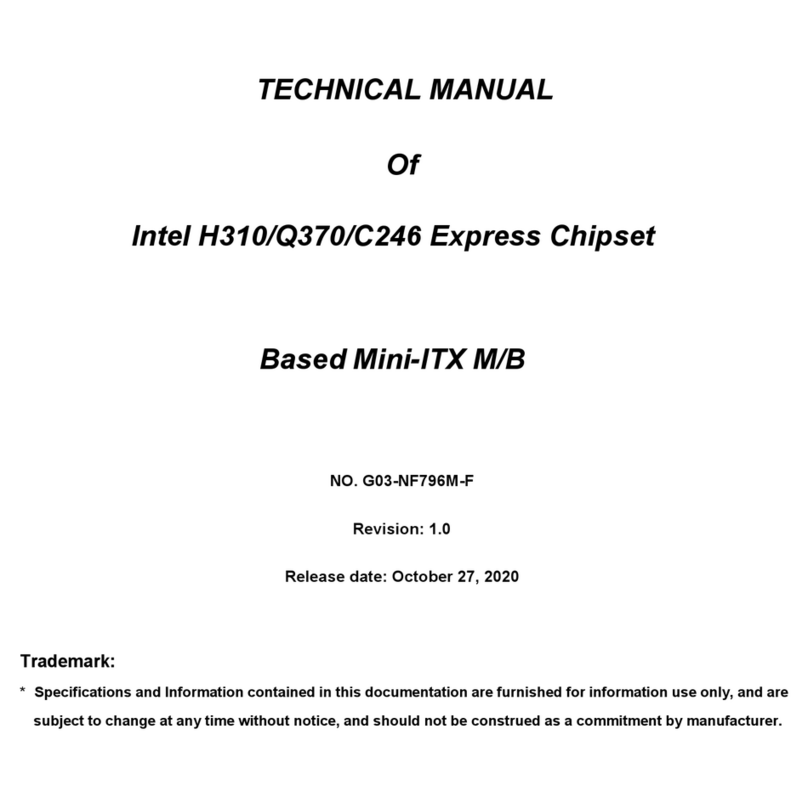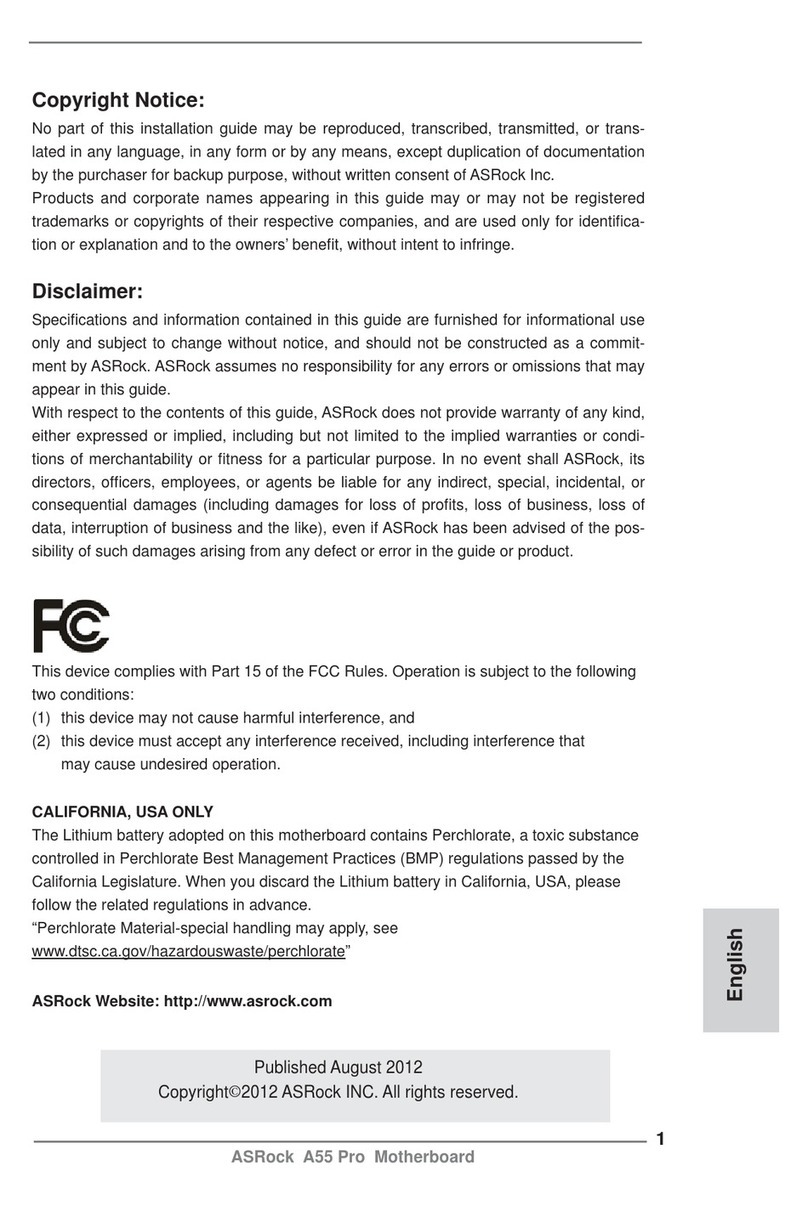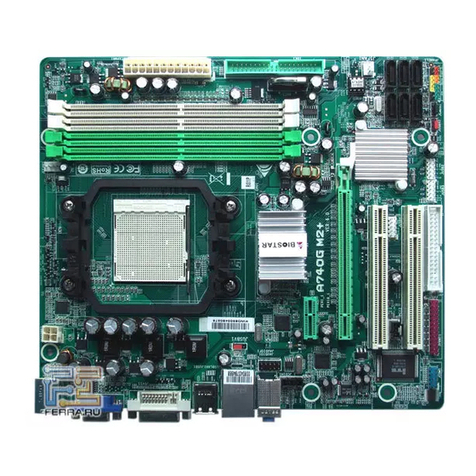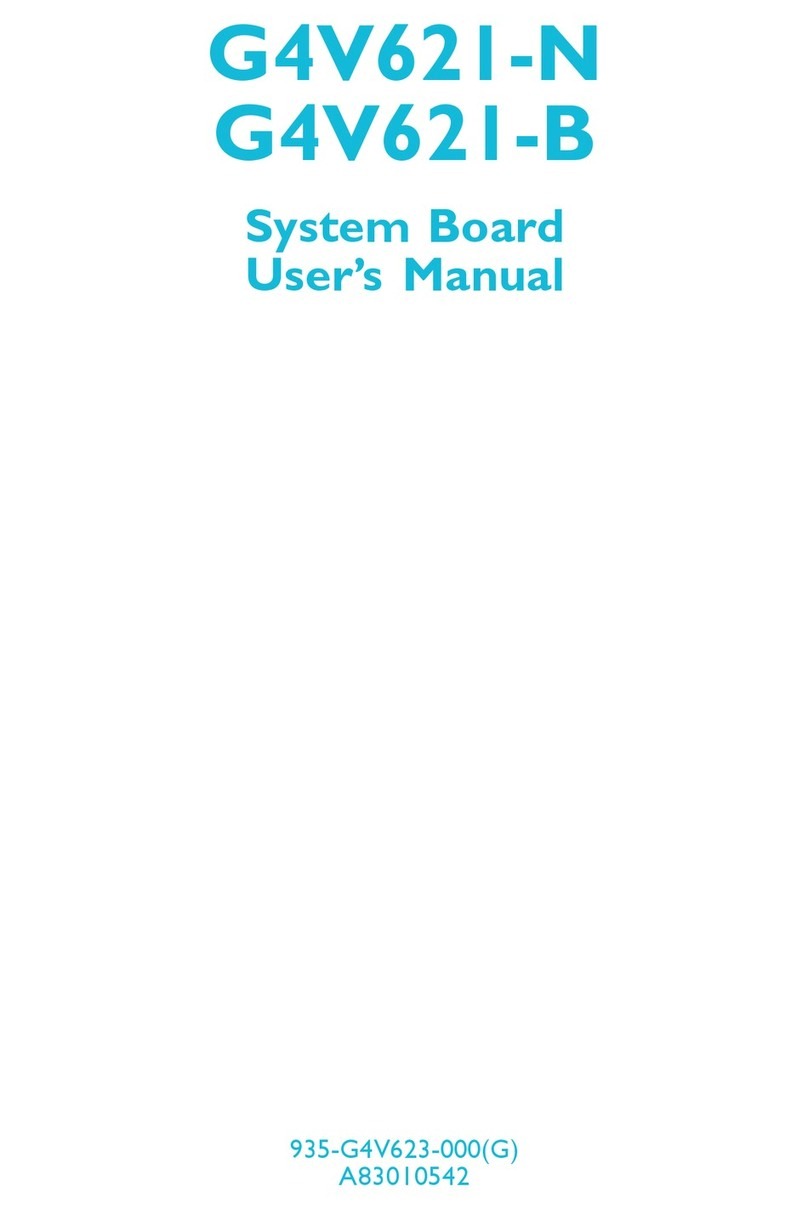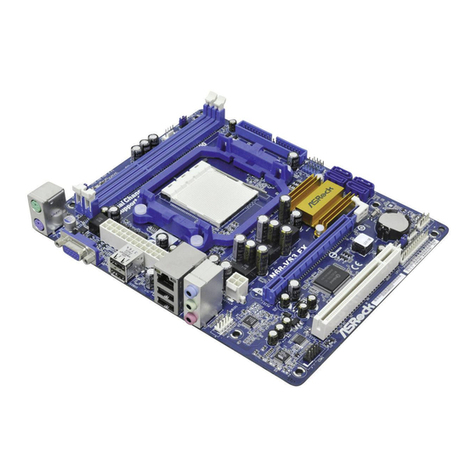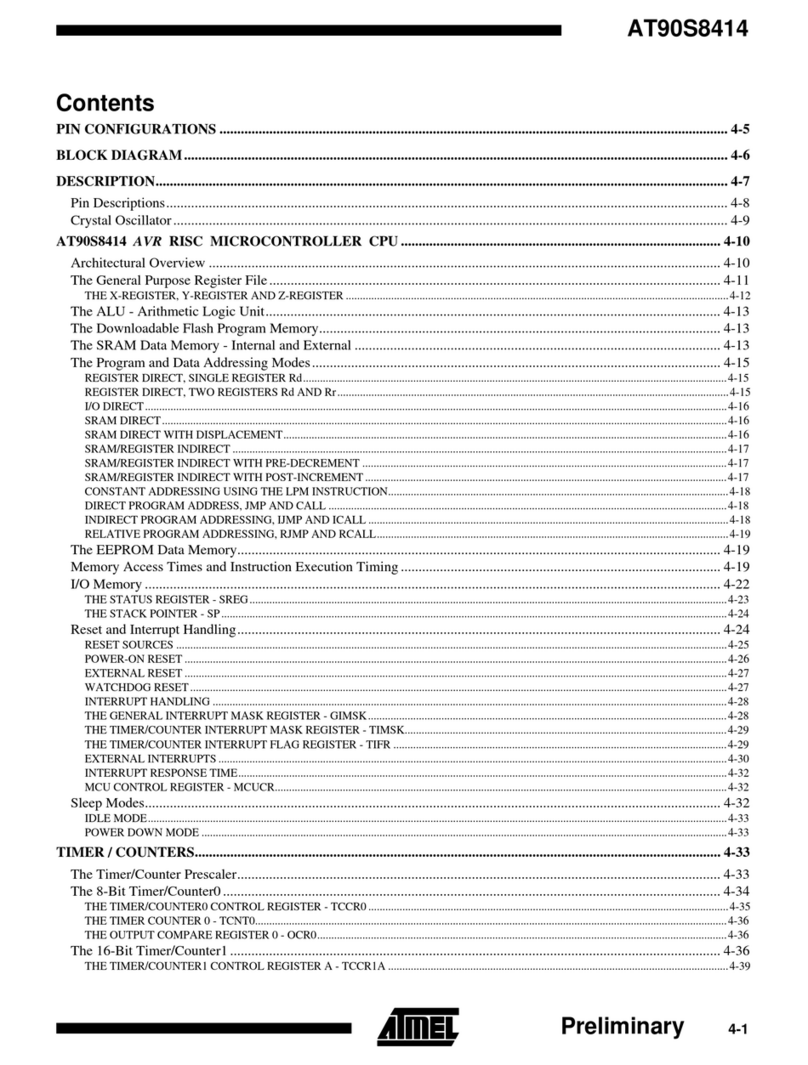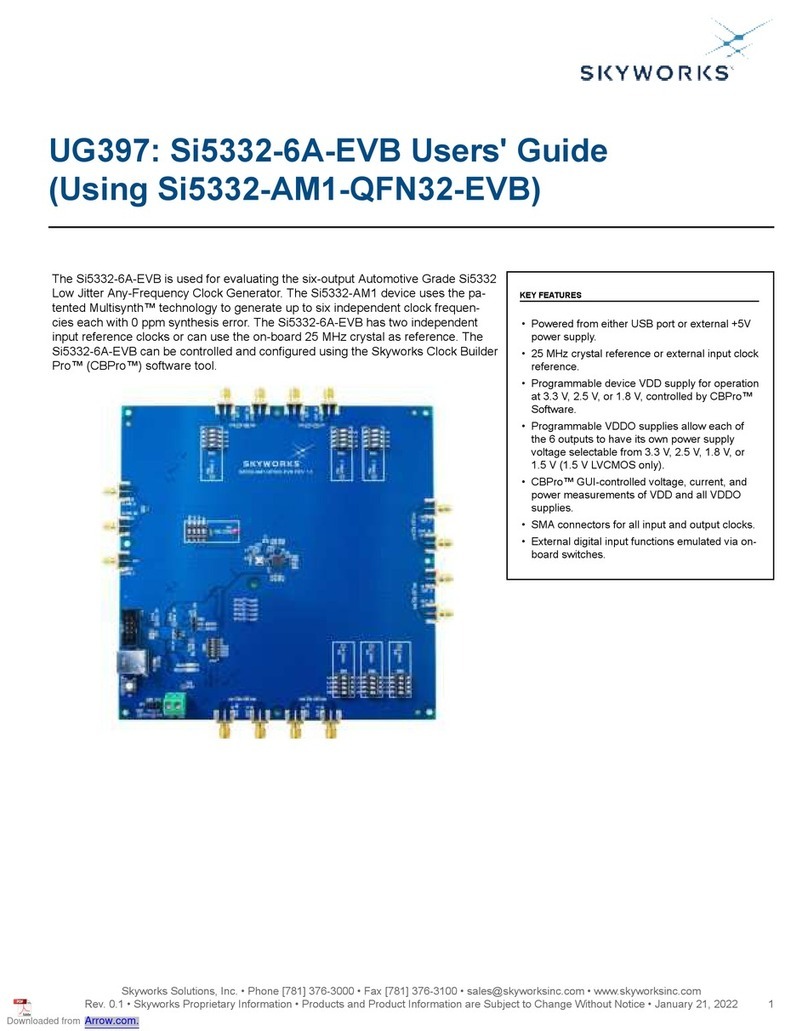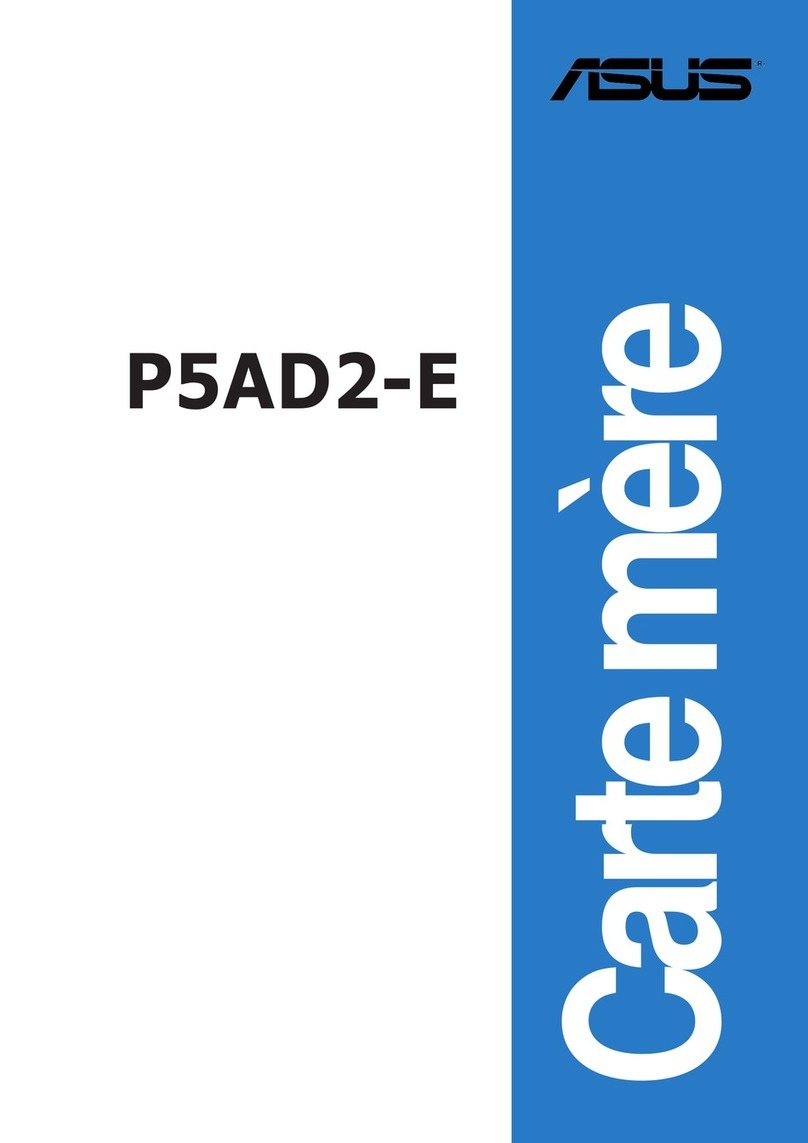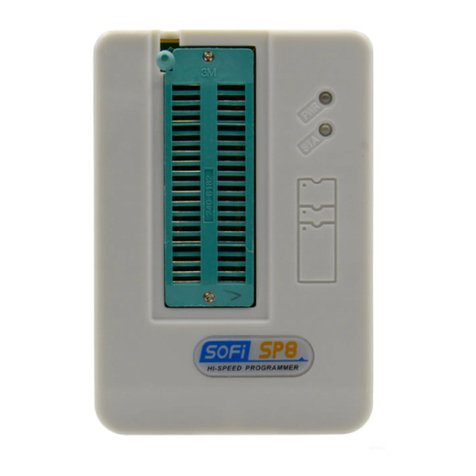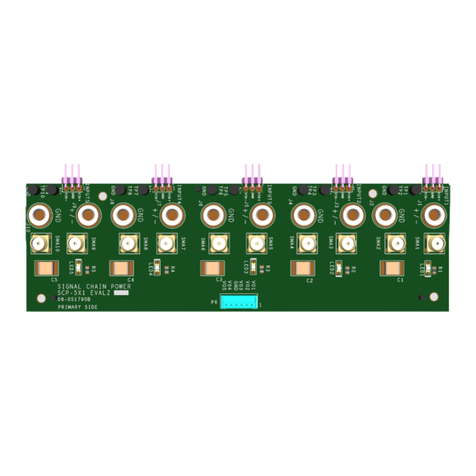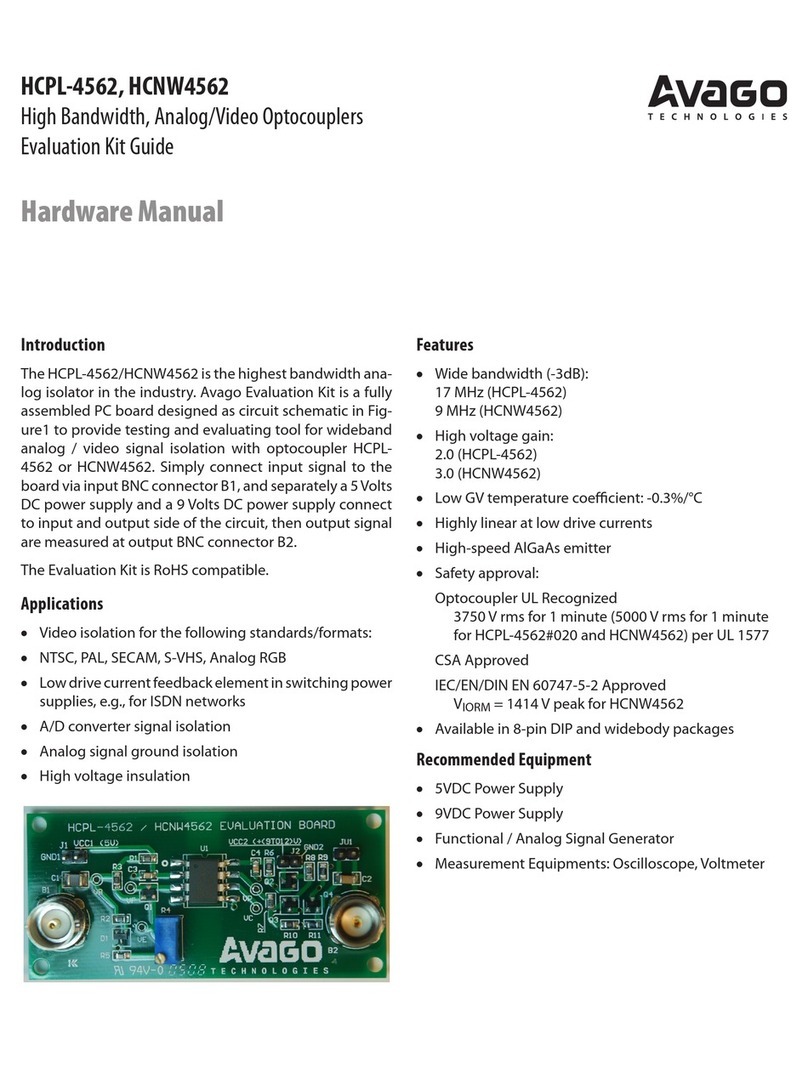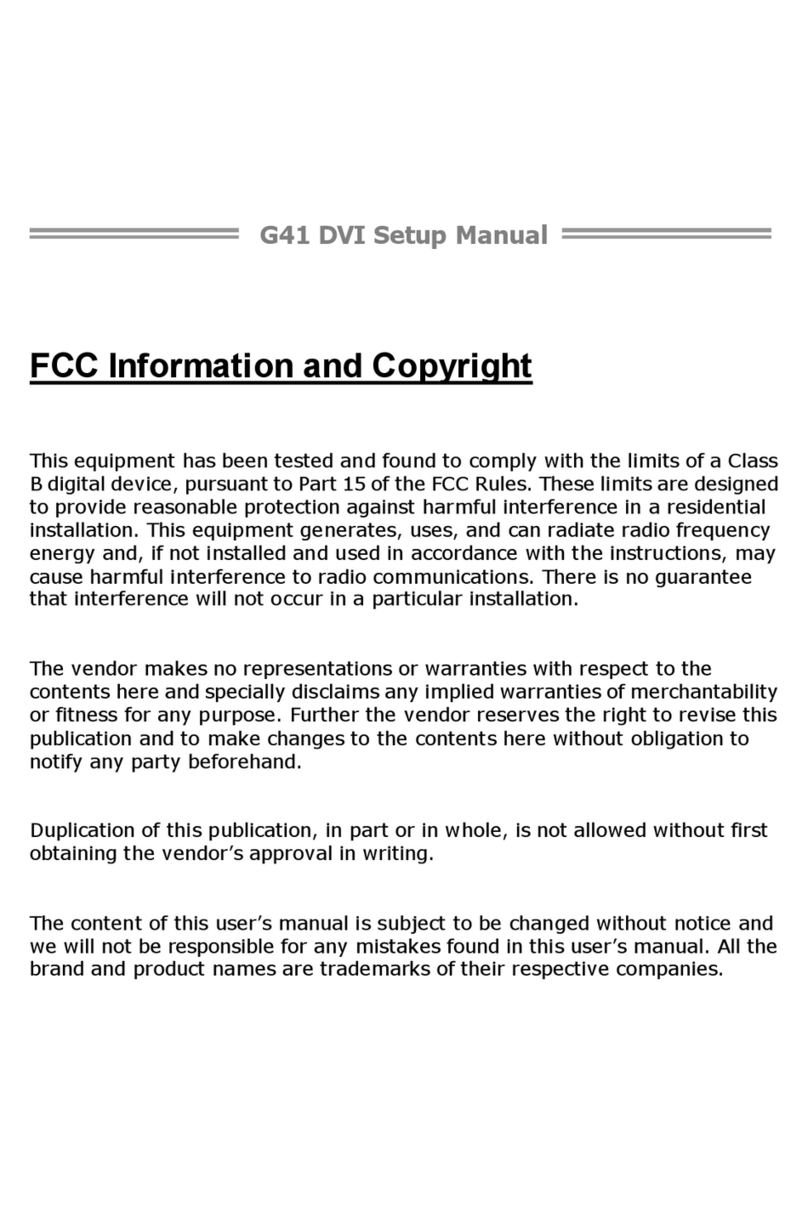Lippert Components Thunderbird-GM45 User manual

TME-ITX-GM45-R1V1
Revision 1.1 / October 09
©
LIPPERT
Embedded omputers GmbH
Hans-Thoma-Str. 11
D-68163 Mannheim
http://www.lippert-at.com/
Thunderbird-GM45
Mini-ITX Motherboard
Technical Manual

TME-ITX-GM45-R1V1 Rev 1.1
Technical Manual Thunderbird-GM45
LiPPERT Document: TME-ITX-GM45-R1V1.doc Revision 1.1
opyright © 2007 LiPPERT Embedded omputers GmbH, All rights reserved
ontents and specifications within this manual are subject of change without notice.
Trademarks
MS-DOS, Windows, Windows 95, Windows 98, Windows NT and Windows XP are trademarks of
Microsoft orporation. PS/2 is a trademark of International Business Machines, Inc. Intel and
Pentium are trademarks of Intel orporation. Geode is a trademark of Advanced Micro Devices, Inc.
M-Systems and DiskOn hip are trademarks or registered trademarks of M-Systems Flash Disk
Pioneers, Ltd. P /104 is a registered trademark of P /104 onsortium. All other trademarks
appearing in this document are the property of their respective owners.

TME-ITX-GM45-R1V1 Rev 1.1 i
Table of Contents
1. Overview 4
1.1
Introduction .......................................................................................... 4
Features ................................................................................................. 4
Block Diagram......................................................................................... 1
1.
Ordering Information.............................................................................
Thunderbird-GM45 Models ........................................................................ 2
able Sets and Accessories ....................................................................... 2
1.3
Specifications ........................................................................................ 3
Electrical Specifications ............................................................................ 3
Environmental Specifications..................................................................... 3
MTBF ..................................................................................................... 3
Mechanical.............................................................................................. 3
. Getting Started 4
.1
Connector Locations .............................................................................. 4
Top ........................................................................................................ 4
Bottom ................................................................................................... 5
.
LED Indicators ....................................................................................... 6
.3
Hardware Setup ..................................................................................... 7
3. Module Description 8
3.1
Processor............................................................................................... 8
3.
Northbridge ........................................................................................... 8
3.3
Southbridge ........................................................................................... 9
3.4
Graphics Controller ................................................................................ 10
DVI onnector........................................................................................10
LVDS.....................................................................................................11
LVDS onnector .....................................................................................11
Display Backlight onnector .....................................................................12
Display Voltage Selector ..........................................................................12
3.5
Network................................................................................................. 13
Ethernet connector .................................................................................13

TME-ITX-GM45-R1V1 Rev 1.1 ii
3.6
USB .0 Ports......................................................................................... 14
USB connectors (0-3)..............................................................................14
USB connectors (4-5)..............................................................................14
3.7
SATA Ports............................................................................................. 15
3.8
On Board Power Supply ......................................................................... 15
Power onnector ....................................................................................15
Real Time lock Backup...........................................................................15
3.9
System Panel Connector ........................................................................ 16
ontrol onnector...................................................................................16
3.10
PCI-Bus ................................................................................................. 16
3.11
Mini-PCIe ............................................................................................... 17
3.1
Adaptive I/O.......................................................................................... 18
3.13
CPU Fan Supply...................................................................................... 19
3.14
Chassis Fan Supply ................................................................................ 19
4. Using the Module 0
4.1
BIOS ...................................................................................................... 0
Setup ....................................................................................................20
Initialize BIOS at first startup ...................................................................20
Booting from alternative device ................................................................20
Reload default BIOS values ......................................................................21
BIOS Screens .........................................................................................22
5. Address Maps 8
Memory Address Map ..............................................................................28
I/O Address Map.....................................................................................29
Interrupts ..............................................................................................30
DMA hannels ........................................................................................30
6. Troubleshooting 31
Appendix A, Contact Information 1
Appendix B, Getting Help
Appendix C, Further Resources 3
Appendix D, Revision History 4

TME-ITX-GM45-R1V1 Rev 1.1 iii

TME-ITX-GM45-R1V1 Rev 1.1 4
1. Overview
1.1 Introduction
The brand name for the product is defined as Thunderbird-GM45.
The Mini ITX board Thunderbird-GM45 is designed for applications where a high performance x86
compatible dual core processor board is necessary. The board concept offers a lot of standard
I/O interfaces. In junction with Lippert’s ‘AdaptiveIO expansion system’ it is possible to design
simple ‘AdaptiveIO Modules’ (AdaptiveIO-MM, AdaptiveIO-Legacy,) with special interfaces that
are needed just for his application.
The onboard connectors will have a max. height of about 16mm, so that there is enough room to
insert a second I/O level, giving the customers numerous possibilities to expand their system in
a custom way.
The Thunderbird-GM45 is designed by using latest chipset technology platform from Intel, called
Montevina. The PU/chipset will be found on Intel’s embedded roadmap ensuring long time
availability.
Features
•Intel ore 2 Duo with Montevina chipset
•Integrated graphics controller
•DVI, 1600 x 1200 pixels
•LVDS, 24/18 bits, 1600 x 1200 pixels
•Gigabit LAN
•4 x USB 2.0
•uDO or 2 x USB 2.0 internal
•4 x SATA
•Mini- ard P Ie x1 (+ 1x USB 2.0)
•Adaptive-I/O™
•LEMT management functions
•Low power consumption
•Optionally extended temperature range -40 ... +85°

TME-ITX-GM45-R1V1 Rev 1.1 Page 1 of 31
Block Diagram

TME-ITX-GM45-R1V1 Rev 1.1 Page 2 of 31
1. Ordering Information
Thunderbird-GM45 Models
Order number Description
805-0008-10 Thunderbird-GM45 Mini-ITX PU board with T9400 Intel ore 2 Processor
(2.53 GHz, 6MB L2 cache, 1066 MHz FSB)
Operating temp. range: -20° … +60°
Cable Sets and Accessories
Order number Description
862-0055-10 able, ID 10 (2.54mm) to 2x USB (A)

TME-ITX-GM45-R1V1 Rev 1.1 Page 3 of 31
1.3 Specifications
Electrical Specifications
Supply voltage 12V ± 2%
Rise time < 10 ms
Supply voltage ripple ± 50 mV
Inrush current tbd.
Supply current
805-0008-10
max. 3.6 A depending on usage and operating system
typ. 2.9 A
Environmental Specifications
Temperature range -20 … 60 ° (standard, for models with serial numbers 8xx-xxxx-xx)
-40 … 85 ° (extended, for models with serial numbers 9xx-xxxx-xx)
Storage temperature -40 … 85 °
Temperature change max. 10K / 30 minutes
Humidity (relative) 10 … 90 % (non-condensing)
Pressure 450 … 1100 hPa
MTBF
MTBF at 25° 143737 hours
Mechanical
Dimensions (L x W) 170 mm x 170 mm (6.689 x 6.689-inch) 6.689" by 6.689"
Height approx. 32 mm with PU / chipset cooler above P B
approx. 4 mm below P B
P B thickness 1.6 mm
total height approx. 37.6 mm
Weight 500 gr
Mounting 4 mounting holes for Mini-ITX
Note It is strongly reco end using plastic spacers instead of etal spacers to
ount the board. With etal spacers, there is a possible danger to create
a short circuit with the co ponents located around the ounting holes.
This can da age the board!

TME-ITX-GM45-R1V1 Rev 1.1 Page 4 of 31
. Getting Started
.1 Connector Locations
Top
X7
X1
X 1
X16
X15
X19
X17
X
1
X18
1
X10
X4
X
X9
X11
LED
1 3 4 5 9
X 1
X3
X6
X5
X 3
1
X8
1
JP1
1
X13

TME-ITX-GM45-R1V1 Rev 1.1 Page 5 of 31
Bottom
X 7
X 5

TME-ITX-GM45-R1V1 Rev 1.1 Page 6 of 31
. LED Indicators
To facilitate problem solving, the Thunderbird-GM45 provides LED indicators for the following
conditions:
LED Name Function
1 P10 (SBY) Standby Power Supply
2 P11 (PM) Power Mode
3 P12 (MAIN) Main Power Supply
4 WD Watchdog activated
5 HDD Harddisk: SATA accesses
9 PF Power Fail
LED
1 2 3 4 5 9

TME-ITX-GM45-R1V1 Rev 1.1 Page 7 of 31
.3 Hardware Setup
Installing the Thunderbird-GM45 is very straightforward. First, unpack the board observing the usual
electrostatic discharge (ESD) precautions.
Caution
Before you touch the board, make sure that you have discharged yourself
and your gear towards a grounded terminal. Damages due to ESD are usually
not immediately visible and will only show up later as failures in the field.
Mount the cooling device.
Caution
Never operate the Thunderbird-GM45 without suitable cooling devices. Failing
this can destroy the module.
onnect a display monitor to the DVI connector and keyboard and mouse to USB connectors. Add a
suitable hard drive and/or a D drive to the configuration.
Caution
Never connect or disconnect peripherals like hard drives while the board's
power supply is connected and switched on!
onnect a standard ATX supply and switch on the power.
The display shows the BIOS messages. If you want to change the standard BIOS settings, press the
<DEL> key to enter the BIOS menu. See BIOS chapter for more details.
If you need to load the BIOS default values, press the <Insert> key during startup. This forces the
BIOS to load the factory settings from FlashPROM.
The Thunderbird-GM45 can boot from D drives, USB floppy, USB stick, harddisk, or network.
Provided that any of these is connected and contains a valid operating system image, the display
then shows the boot screen of your operating system.
Note
Not all USB devices are suitable to boot the Thunderbird-GM45.
If there are problems, please try to use another device from another
manufacturer.

TME-ITX-GM45-R1V1 Rev 1.1 Page 8 of 31
3. Module Description
3.1 Processor
Intel
P
®
P
ore
TM
2 Duo Processor, 2.53 GHz.
The Penryn processor on 45-nanometer process technology is the next generation high-performance,
low-power mobile processor based on the Intel® ore™ microarchitecture.
In the platform, the Penryn processor supports the antiga chipset and Intel® I H9M I/O controller.
This document contains electrical, mechanical and thermal specifications for:
•Dual ore Extreme edition (D -XE)
•Standard voltage (SV)
•Low voltage (LV)
•Ultra-low voltage (ULV)
In this document, the Penryn processor will be referred to as the processor and the antiga chipset
will be referred to as the (G)M H. The following list provides some of the key features on this
processor:
•Supports L1 cache-to-cache ( 2 ) transfer
•On-die, primary 32-kB instruction cache and 32-kB write-back data cache in each core
•The Penryn processor in D -XE, SV and LV have an On-die, up to 6-MB second level shared
cache with Advanced Transfer ache architecture
•The Penryn processor in ULV have an On-die, up to 3-MB second-level shared cache with
Advanced Transfer ache architecture
•Streaming SIMD extensions 2 (SSE2), streaming SIMD extensions 3 (SSE3), supplemental
streaming SIMD extensions 3 (SSSE3) and SSE4.1 instruction sets
•The Penryn processor in D -XE, SV and LV are offered at 1066-MHz source synchronous front
side bus (FSB)
•The Penryn processor in ULV are offered at 800-MHz source-synchronous front side bus (FSB)
•Advanced power management features including Enhanced Intel Speed Step® Technology and
dynamic FSB frequency switching
•Digital thermal sensor (DTS)
•Intel® 64 architecture
•Intel® Dynamic Acceleration Technology and Enhanced Multi Threaded Thermal Management
(EMTTM)
•Supports PSI2 functionality
•The Penryn processor in SV is offered in Micro-F PGA and Micro-F BGA packaging technologies
•The Penryn SFF processor in LV and ULV are offered in Micro-F BGA packaging technologies
only
•Execute Disable Bit support for enhanced security
•6 Low Power Feature with P_LVL6 I/O Support
3. Northbridge
Intel
antiga (GM45) with hipset Graphics and Memory ontroller Hub (GM H)
The (G)M H manages the flow of information between various components through four main
interfaces:
•Front Side Bus (FSB)
•System Memory Interface (DDR2)
•Graphics Interfaces ( RT, TV-Out, LVDS, SDVO, Display Port, iHDMI* (DVI also) and P I
Express Graphics)
•Direct Management Interface (DMI)
For detailed information, please refer to the Intel
antiga datasheet.

TME-ITX-GM45-R1V1 Rev 1.1 Page 9 of 31
3.3 Southbridge
The I H9 provides extensive I/O support. Functions and capabilities include:
•PCI Express* Base Specification, Revision 1.1 support
•PCI Local Bus Specification, Revision 2.3 support for 33 MHz P I operations (supports up to four
Req/Gnt pairs).
•A PI Power Management Logic Support, Revision 3.0b
•Integrated Serial ATA host controllers with independent DMA operation on up to four ports and
AH I support.
•USB host interface with support for up to twelve USB ports; six UH I host controllers; two EH I
high-speed USB 2.0 Host controllers
•Integrated 10/100/1000 Gigabit Ethernet MA with System Defense
•Syste Manage ent Bus (SMBus) Specification, Version 2.0 with additional support for I
2
devices
•Supports Intel
®
High Definition Audio
•Supports Intel
®
Matrix Storage Technology (Intel
®
I H9R, I H9DH, I H9DO, I H9M, and
I H9M-E only)
•Supports Intel
®
Active Management Technology (Digital Office only)
•Low Pin ount (LP ) interface
•Firmware Hub (FWH) interface support
•Serial Peripheral Interface (SPI) support

TME-ITX-GM45-R1V1 Rev 1.1 Page 10 of 31
3.4 Graphics Controller
This chapter details the chipset integrated graphics engines (3D, 2D and Video), 3D pipeline and
their respective capabilities.
The (G)M H graphics is powered by the Gen 5.0 Graphics Architecture and supports ten fully
programmable execution cores, enabling greater performance than previous generation chipsets.
Mobile Intel® 45 Express graphics supports full-precision, floating-point operations to enhance the
visual experience of compute-intensive applications.
The (G)M H internal graphics devices (IGD) contain several types of components. The major
components in the IGD are the engines, planes, pipes and ports. The (G)M H has a 3D/2D
Instruction Processing unit to control the 3D and 2D engines respectively. The IGD’s 3D and 2D
engines are fed with data through the memory controller. The outputs of the engines are surfaces
sent to memory, which are then retrieved and processed by (G)M H planes.
DVI Connector
onnector type: DVI-I, female (X10)
PIN Signal
1 TMDS Data 2-
2 TMDS Data 2+
3 TMDS Data 2/4 Shield
4 TMDS Data 4- (n.c.)
5 TMDS Data 4+ (n.c.)
6 DD lock
7 DD Data
8 Analog Vertical Sync
9 TMDS Data 1-
10 TMDS Data 1+
11 TMDS Data 1/3 Shield
12 TMDS Data 3- (n.c.)
13 TMDS Data 3+ (n.c.)
14 +5 V Power
15 GND (+5 V, Analog H/V Sync)
16 Hot Plug Detect
17 TMDS Data 0-
18 TMDS Data 0+
19 TMDS Data 0/5 Shield
20 TMDS Data 5- (n.c.)
21 TMDS Data 5+ (n.c.)
22 TMDS lock Shield
23 TMDS lock +
24 TMDS lock -
1 Analog Red Video Out
2 Analog Green Video Out
3 Analog Blue Video Out
4 Analog Horizontal Sync
5 Analog ommon Ground Return
(Red, Green, Blue Video Out)

TME-ITX-GM45-R1V1 Rev 1.1 Page 11 of 31
LVDS
LVDS for flat panel is compatible with the ANSI/TIA/EIA-644 specification. This is an electrical
standard only defining driver output characteristics and receiver input characteristics.
Each channel supports transmit clock frequency ranges from 25 MHz to 112 MHz, which provides a
throughput of up to 784 Mbps on each data output and up to 112 MP/s on the input. When using
both channels, each carry a portion of the data, thus doubling the throughput to a maximum
theoretical pixel rate of 224 MP/s.
There are two LVDS transmitter channels ( hannel A and hannel B) in the LVDS interface. hannel
A and hannel B consist of 4-data pairs and a clock pair each.
The LVDS data pair is used to transfer pixel data as well as the L D timing control signals.
There is a connector supplying the L -Display's inverter.
LVDS Connector
onnector type: DF14-30P-1.25H (Hirose) (X27)
Pin Signal
1 VDD (3.3 V, opt.5 V)
2 VDD (3.3 V, opt.5 V)
3 GND
4 GND
5 TXA3 -
6 TXA3 +
7 TXA LK -
8 TXA LK +
9 GND
10 TXA2 -
11 TXA2 +
12 TXA1 -
13 TXA1 +
14 TXA0 -
15 TXA0 +
16 GND
17 TXB3 -
18 TXB3 +
19 TXB LK -
20 TXB LK +
21 GND
22 TXB2 -
23 TXB2 +
24 TXB1 -
25 TXB1 +
26 TXB0 -
27 TXB0 +
28 GND
29 LVDS DD - LK
30 LVDS DD -DATA
"A" and "B" in the sign al names denote
the two possible LVDS channels.
X 7

TME-ITX-GM45-R1V1 Rev 1.1 Page 12 of 31
Display Backlight Connector
onnector type: Hirose DF13 8 Pin (X25)
Display Voltage Selector
Jumper X11, Location is top near X18 (SYSTEM PANEL ONNE TOR).
onnector type: ID 6 jumper 2.00 mm.
Use a jumper between 1-3 or 3-5 to select the backlight voltage.
Use a jumper between 2-4 or 4-6 to select the display voltage.
Default setup is 3,3V for LVDS display and 12V for the inverter.
Pin Direction
Signal
1 Output +12 V D , max. 1A
2 Output +12 V D , max. 1A
3 Output +5 V D , max. 1A
4 Output +5 V D , max. 1A
5 Output Signal: Backlight enable (level: 3.3 V)
6 Output Switched Inverter Power, max. 1A (refer
to “Display Voltage Selector” below)
7 GND
8 GND
Pin
Signal name Pin
Signal name
1 +3,3V D 2 +12V D
3 Display voltage 4 Backlight voltage
5 +5V D 6 +5V D
X 5
X11
X18
1

TME-ITX-GM45-R1V1 Rev 1.1 Page 13 of 31
3.5 Network
Ethernet controller: Intel 82567
Ethernet connector
onnector type: RJ45 (X4)
PIN Signal (Port A)
1 GND
2 V
3 MDI3+
4 MDI3-
5 MDI2+
6 MDI2-
7 MDI1+
8 MDI1-
9 MDI0+
10 MDI0-
11 LED1-A
12 LED1-K
13 LED2-A
14 LED2-K
15 PE
16 PE

TME-ITX-GM45-R1V1 Rev 1.1 Page 14 of 31
3.6 USB .0 Ports
The Southbridge (I H9) contains two Enhanced Host ontroller Interface (EH I) host controllers
which support up to ten USB 2.0 high-speed root ports. USB 2.0 allows data transfers up to 480Mb/s
using the same pins as the ten USB full-speed/low-speed ports. The I H9 contains port-routing logic
that determines whether a USB port is controlled by one of the UH I controllers or by one of the
EH I controllers.
Four (USB 0/3) of the eleven USB 2.0 host ports are available for the application on two USB
connectors, each providing two ports.
Two USB 2.0 host ports (USB 4/5) are supported at the µDO . The rest of the USB 2.0 host ports
are provided by Mini-P Ie (USB 6) and Adaptive I/O (USB 7/10).
The ports 0 to 5 uses the first EH I and the ports 6 to 10 uses the second EH I.
USB connectors (0-3)
onnector type: 2xUSB
USB0/1
PIN Signal
1 USB_V
2 USB0/1-
3 USB0/1+
4 GND
USB2/3
PIN Signal
1 USB V
2 USB2/3-
3 USB2/3+
4 GND
USB connectors (4-5)
onnector type: ID 10 pin header 2.54 mm
Adapter cable: available, art.no. 862-0055-10
PIN Signal PIN Signal
1 USB_V -4 2 USB_V -5
3 USB4- 4 USB5-
5 USB4+ 6 USB5+
7 GND-4 8 GND-5
Key 10 N.c
This connector is prepared for µDO (uDiskOn hip from M-Systems, www.m-sys.com) usage!
µDO is a high-speed flash disk with USB 2.0 Interface.
2
3
4
5
6
7
8
10
1
Table of contents
